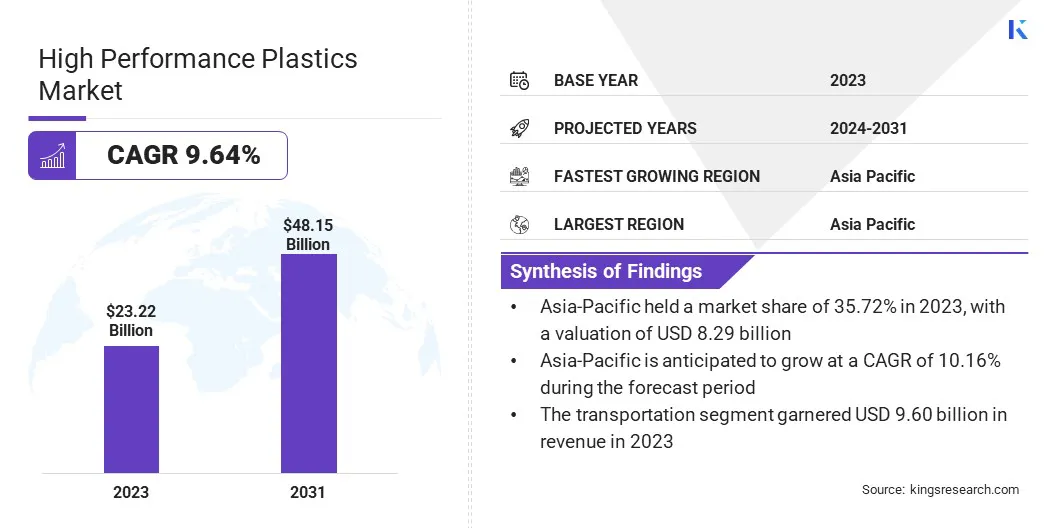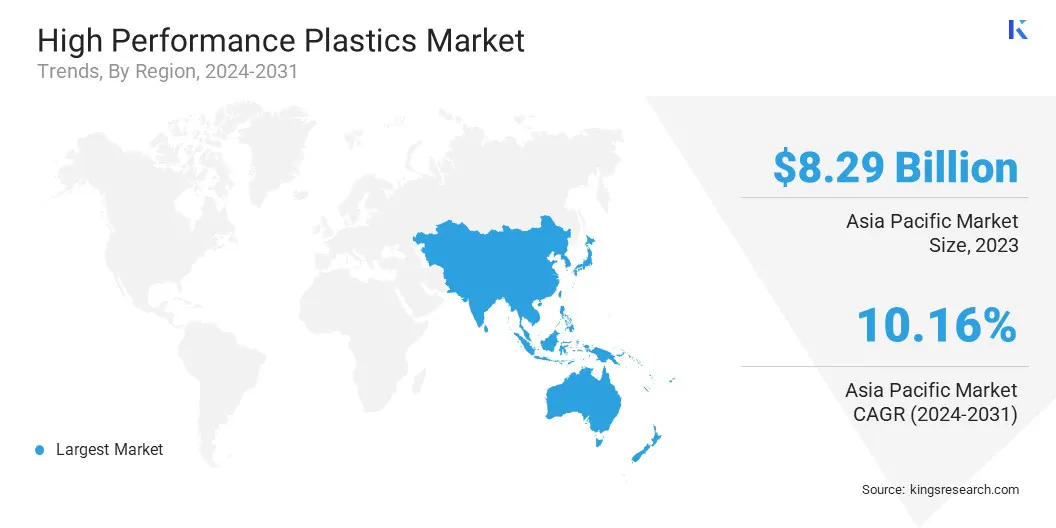The global High Performance Plastics Market size was valued at USD 23.22 billion in 2023, and is projected to grow from USD 25.27 billion in 2024 to USD 48.15 billion by 2031, exhibiting a CAGR of 9.64% during the forecast period.
The global market is experiencing steady growth due to the increasing demand from the aerospace sector, where these materials are used in structural components, insulations, and seals. The rise of high performance plastics in wind turbines is further driving market expansion.
In the scope of work, the report includes services offered by companies such as Arkema, Daikin Industries, Ltd., Evonik Industries, Asahi Kasei Corporation, SABIC, Victrex plc., 3M, KUREHA CORPORATION, Polyplastics Co., Ltd, Celanese Corporation, and others.
The surge in automotive manufacturing is contributing significantly to the growth of the high performance plastics industry, due to their metal replacement potential and high-temperature stability. Automotive polymers offer vibration and abrasion resistant, durability, and excellent tactile properties.
These plastics are utilized in various automotive parts, including electrical parts, engine parts, and body and chassis parts.
- For instance, in January 2023, Italian automobile manufacturer Bertone Inc. intorduced the GB110 hyper car, an innovative and environmentally conscious vehicle powered by plastic waste.
The growing adoption of electric vehicles boosts the demand for high performance plastics, as they are lighter than conventional materials, enhancing fuel efficiency and potentially reducing greenhouse gas emissions.
High performance plastics are specialized polymers known for their exceptional strength, durability, temperature resistance, chemical resistance, and ability to withstand wear and damage. Designed for use in harsh environments and severe conditions, their demand is rising owing to the rising focus on energy efficiency and lightweight materials.
These plastics are primarily derived from synthetic materials such as polyetheretherketone (PEEK), polytetrafluoroethylene (PTFE), polyphenylene oxide (PPO) and, polyphenylene oxide copolymer (PPCO). They can be processed using different molding techniques and are commonly used in manufacturing components for a wide range of the applications, including those subject to food and drug regulations.
- According to 21 CFR Part 177 of the Code of Federal Regulations, specific high performance plastics are deemed safe for use in food applications. Rigid and semirigid acrylic and modified acrylic plastics utlized in food applications.
High performance plastics are regulated by various standards to ensure their safe use in numerous applications.

Analyst’s Review
The growing demand for high performance plastics is driven by their exceptional performance at high temperatures, along with excellent anticorrosion, thermal conductivity properties, mechanical strength, and chemical resistance.
This demand is expected to rise due to their thermal stability and durability. Additionally, the expansion of industries such as aerospace, automotive, and electronics, particularly in emerging economies.
- For instance, in April 2023, BASF launched a high performance thermoplastic elastomer for electrical and electronics applications, anticipated to offer flexibility, dielectric properties, and flame retardancy.
Key market players are focusing on the development of lightweight, energy-efficient solutions, particularly within the electronics and automotive sectors.
The growing demand in the electronics industry is contributing significantly to the growth of the high performance plastics market. These materials offer exceptional thermal stability, electrical insulation, and resistance to environmental factors. High performance plastics enable the development of efficient, lightweight, and compact electronic products, ensuring the safety and reliability of critical components.
- For instance, in 2023, MDPI reported a significant increase in the use of liquid crystal polymers in the automotive and electronics sectors, primarily for sensors, high-thermal stability components, and connectors.
Additionally, technological advancements in high performance plastics, including the development of high temperature resistant polymers and engineering-grade plastic, are broadening their applications in the electronics industry, fostering market growth.
The high performance plastics market faces challenges due to high production costs and variations in raw material prices. Materials such as fluoropolymers, polyphenylene sulphide (PPS), sulfone polymers (SP), and polyamides require advanced manufacturing processes, specialized equipment, and expensive raw materials, making them costlier than conventional plastics.
Industries such as automotive, medical, and aerospace often struggle with budget constraints. Additionally, the fluctuating prices of raw materials have significantly impacted production costs. These plastic are mainly derived from chemicals such as toluene, xylene, and benzene. Furthermore, the rising demand for viable alternatives, such as recycled raw materials, further hamper market growth.
Advancements in aerospace technology are fueling the demand for high performance plastics. These materials, essential for optimizing performance and fuel efficiency,must withstand extreme temperatures while meeting stringent quality standards over extended periods.
High-performance plastics such as polyimide, polytetrafluoroethylene (PTFE), polyether ether ketone (PEEK), and polyvinylidene fluoride (PVDF) are gaining prominence due to their unique combination of versatility, durability, and lightweight properties. This makes them integral to aircraft manufacturing and design.
- For instance, in May 2023, DuPont introduced a high performance thermoset resin for aerospace applications, providing enhanced stiffness, strength, and chemical resistance.
PTFE is widely utilized in aircraft applications for seals, bearings, and electrical insulation due to its exceptional lubricity, which ensures smooth mechanical movement while minimizing wear and friction. Its high resistance to corrosion and strong chemicals makes it ideal for hydraulic system seals and gaskets, enhancing aircraft reliability and durability.
Similarly, PEEK, with its lightweight properties and specific gravity of 1.35, which is nearly half that of aluminum, offers a remarkable strength-to-weight ratio. This enables the replacement of metal components in a wide range of aeronautical applications.
The increasing demand for high performance plastics in medical devices is fostering market growth, attributed to their durability, biodegradability, and shape-memory capabilities. These materials are extensively used in dental implants and orthodontic procedures.
Polyetheretherketone (PEEK), a high-performance thermoplastic polymer, is particularly suitable for use in dental implant abutments due to its bone-like elastic modulus, which reduces stress shielding. PEEK has become indespensible in dental applications due to its high temperature resistance, biocompatibility and chemical resistance.
It is commonly utilized in dental implants, braces, and dental crowns for its flexibility, durability, and corrosion resistance. Additionally, hHigh performance plastics enhance patient outcome by reducing pain and treatment costs while lowering replacement rates. They are further employed in ventilator production, offering adaptability and seal under challenging conditions.
Segmentation Analysis
The global market has been segmented based on type, end-use, and geography.
By Type
Based on type, the high performance plastics market has been segmented into fluoropolymers, polyamides, polyphenylene sulfide (PPS), sulfone polymers (SP), liquid crystal polymers (LCP), and others. The fluoropolymers segment garnered the highest revenue of USD 5.44 billion in 2023, fueled by their heat stability and electrical properties, and unique non-adhesive and low-friction characteristics.
They are extensively used in semiconductors, automotive, and common household equipment due to their exceptional resistance to heat, weather, chemicals, and superior electrical performance resistance properties.
- For instance, in 2023, Daikin Air-conditioning India announced plans to open its third manufacturing plant in India. The 75-acre facility in Sri City, Andhra Pradesh, aims to meet the rising local and global demand for Indian-made air conditioning products.
Fluoropolymers exhibit exceptional resistance to an extensive range of acids, base, and corrosive chemicals. With excellent electrical insulation and non-stick properties, they are used in purification systems, refrigeration, and air conditioning equipment.
By End-use
Based on end-use, the market has been categorized into transportation, electrical & electronics, industrial, construction, medical, and others. The transportation segment is expected to garner the highest revenue of USD 22.71 billion by 2031. This growth is attributed to the increasing adoption of high performance plastics in the automotive industry.
These materials contribute to weight reduction, which helps lower carbon emissions and fuel consumption while supporting the rising demand for electric vehicles. Additionally, their corrosion resistance and durability make them ideal for use in harsh environments.
High-performance plastics are commonly used in automotive parts and insulation due to their outstanding chemical resistance, heat resistant, and superior electrical properties.
Available in both granular and powder forms, these fluoropolymers are well-suited for extrusion and compression molding, offering significant advantages over conventional plastics.
Based on region, the global market has been classified into North America, Europe, Asia-Pacific, MEA, and Latin America.

Asia-Pacific high performance plastics market accounted for the largest share of 35.72% in 2023, with a valuation of USD 8.29 billion. Expanding electronic sector, rapid industrialization, rising automotive production, and a focus on material innovation and sustainability are boosting segmentla growth.
Developing countries such as India and China, with the world's largest population, are among the fastest-growing economies in the region.
- For instance, in November 2024, SABIC inaugurated a new ULTEM resin manufacturing facility in Singapore, with an investment of US$170 million (S$220 million).
The growing demand for electrical and electronics device, fueled by population growth, presents significant opportunities for both new and established manufacturers. Additionally, strong economic growth, increasing foreign direct investment (FDI), and affordable labor in developing countries are boosting the demand of high performance plastics in the region.
Europe high performance market is anticipated to witness significant growth, recording a CAGR of 9.54% over the forecast period. A strong focus on sustainability and carbon emission reduction is accelerating the adoption of high-performance materials in electric vehicles.
Europe is home to innovative vehicle manufacturers and numerous investors. Furthermore, high performance plastic are extensively used in automotive production for their ability to reduce vehicle weight while offering superior physical and chemical properties compared to conventional plastics. Additionally, increased awareness of health and hygiene awareness has led to improved healthcare procedures and treatment in hospitals across the region.
Competitive Landscape
The global high performance plastics market report will provide valuable insight with an emphasis on the fragmented nature of the industry. Prominent players are focusing on several key business strategies such as partnerships, mergers and acquisitions, product innovations, and joint ventures to expand their product portfolio and increase their market shares across different regions.
Companies are implementing impactful strategic initiatives, such as expanding services, investing in research and development (R&D), establishing new service delivery centers, and optimizing their service delivery processes, which are likely to create new opportunities for market growth.
List of Key Companies in High Performance Plastics Market
- Arkema
- Daikin Industries, Ltd.
- Evonik Industries
- Asahi Kasei Corporation
- SABIC
- Victrex plc.
- 3M
- KUREHA CORPORATION
- Polyplastics Co., Ltd
- Celanese Corporation
Key Industry Developments
- June 2023 (Launch): Solvay launched a new high performance thermoplastic resin for automotive applications, designed to offer enhanced stiffness, strength, and thermal resistance.
- March 2023 (Launch): Invibio Biomaterial Solutions launched the PEEK-Optima Am Filament, mainly designed for 3-D printed medical devices.
- March 2023(Launch): DSM has launched a high performance thermoplastic composite for construction applications. The resin is engineered to offer enhanced stiffness, strength, and weather resistance.
The global high performance plastics market is segmented as:
By Type
- Fluoropolymers
- Polyamides
- Polyphenylene Sulfide (PPS)
- Sulfone Polymers (SP)
- Liquid Crystal Polymers (LCP)
- Others
By End-use
- Transportation
- Electrical & Electronics
- Industrial
- Construction
- Medical
- Others
By Region
- North America
- Europe
- France
- UK.
- Spain
- Germany
- Italy
- Russia
- Rest of Europe
- Asia-Pacific
- China
- Japan
- India
- South Korea
- Rest of Asia-Pacific
- Middle East & Africa
- GCC
- North Africa
- South Africa
- Rest of Middle East & Africa
- Latin America
- Brazil
- Argentina
- Rest of Latin America


